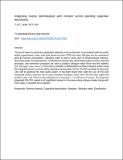| dc.description.abstract | The use of water for particular application depends on its purity level. In accordance with the world health organization, water with total dissolved salts (TDS) less than 500 ppm can be considered good for human consumption. Ultrapure water is used in areas such as semiconductor industry, pharmaceuticals, and laboratories. Purification processes like electrodeionization process, thermal processes, and membrane processes are used to produce ultrapure water from very low salinity (10–200 ppm) water source. In this study, seawater is desalinated to produce ultrapure water using the integrated reverse osmosis (RO)-capacitive deionization (CDI). The RO permeate is fed to the CDI cell to generate the high purity water. It has been found that, with the use of RO-CDI integrated system, seawater can be used to produce ultrapure water with TDS less than 2 ppm and potable water with TDS less than 400 ppm by consuming 3.171 kWh/m3 of energy. The proposed integrated RO-CDI system is of significant interest in the areas where ultrapure water along with fresh water is required from seawater. | en_US |

